Dell Business Model Canvas 2024
While Dell began as a humble PC manufacturer in a college dorm room, it has since evolved into a multinational technology powerhouse, offering a diverse array of products and services that span from personal computers to enterprise solutions. In this Dell Business Model Canvas, I will identify its customer segments, value proposition, revenue streams, channels, customer relationships, key activities, key resources, key partners, and cost structure.
Interesting fact!
Dell’s logo, known as the “tilted E,” was designed by Siegel+Gale and introduced in 1989. It remained unchanged for nearly 30 years until a slight modification in 2016.
Dell Competitors
HP | Lenovo | Apple | Acer | Asus | Microsoft | IBM | Fujitsu | Toshiba | Huawei
Customer Segments – Dell Business Model Canvas
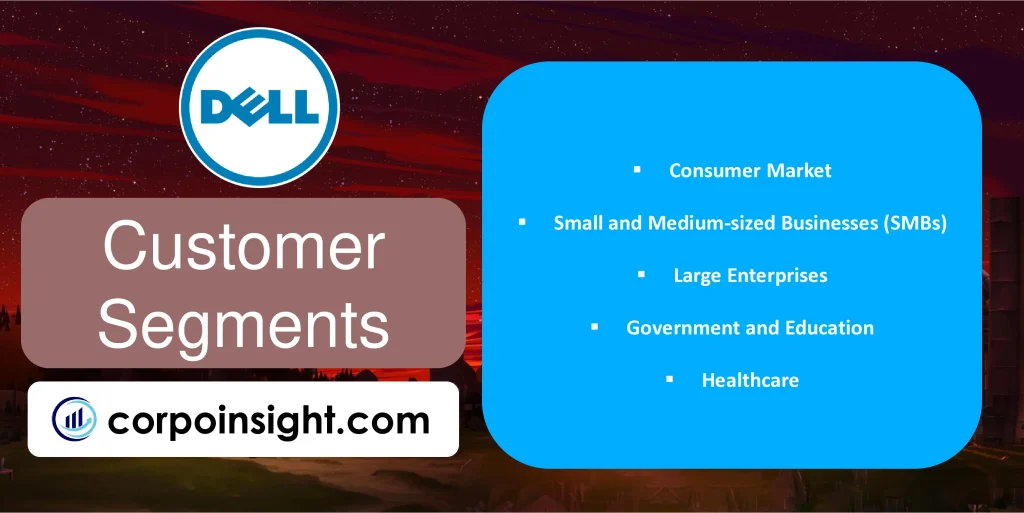
Consumer Market: Dell targets individual consumers and households with its Inspiron and XPS lines, offering a range of laptops, desktops, and accessories that cater to various needs and budgets; while this segment has faced stiff competition from rivals like HP and Lenovo, Dell has maintained a strong presence through competitive pricing and customization options.
Small and Medium-sized Businesses (SMBs): Through its Vostro and Latitude product lines, Dell addresses the unique needs of SMBs, providing cost-effective solutions that balance performance and affordability; this segment has become increasingly important for Dell, as it leverages its direct sales model to offer tailored solutions and support services.
Large Enterprises: Dell’s PowerEdge servers, Precision workstations, and enterprise-grade solutions target Fortune 500 companies and other large organizations, offering scalable infrastructure and end-to-end IT solutions; in this segment, Dell competes fiercely with HP Enterprise and Lenovo, focusing on innovation in areas such as cloud computing and data center management.
Government and Education: With specialized products and services designed for public sector needs, Dell has established a strong presence in government agencies and educational institutions; the company’s commitment to security, compliance, and scalability has made it a preferred choice for many public organizations seeking reliable IT infrastructure and support.
Healthcare: Recognizing the growing importance of technology in healthcare, Dell has developed targeted solutions for hospitals, clinics, and research institutions; by offering specialized hardware, software, and services that address patient care, data management, and regulatory compliance, Dell has positioned itself as a key player in this rapidly evolving sector.
Value Proposition – Dell Business Model Canvas
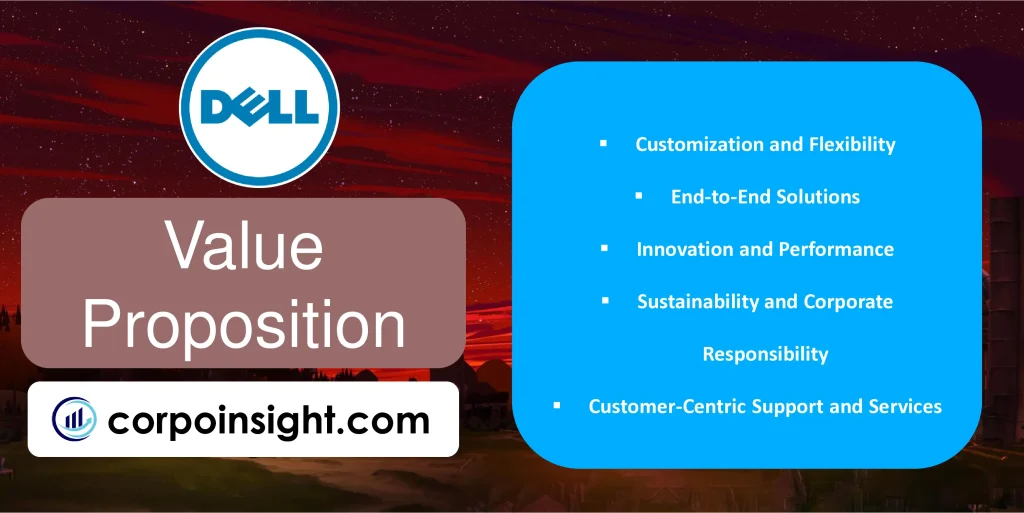
Customization and Flexibility: Dell’s build-to-order model allows customers to configure products to their exact specifications, offering a level of personalization that sets it apart from competitors; this approach, combined with Dell’s efficient supply chain management, enables the company to deliver tailored solutions while maintaining competitive pricing.
End-to-End Solutions: By providing a comprehensive portfolio of hardware, software, and services, Dell positions itself as a one-stop shop for IT needs; this integrated approach, further enhanced by strategic acquisitions like EMC, allows Dell to offer seamless solutions that address complex business challenges across various industries.
Innovation and Performance: Dell consistently invests in research and development to deliver cutting-edge technology, as evidenced by its advancements in areas such as artificial intelligence, edge computing, and 5G; this commitment to innovation ensures that Dell’s products and services remain at the forefront of technological capabilities.
Sustainability and Corporate Responsibility: Dell has made significant strides in sustainability, implementing programs like closed-loop recycling and committing to ambitious environmental goals; this focus on corporate responsibility not only appeals to environmentally conscious consumers but also helps businesses meet their own sustainability objectives.
Customer-Centric Support and Services: Dell’s comprehensive support offerings, including ProSupport and ProSupport Plus, provide customers with rapid, expert assistance and proactive issue resolution; this customer-centric approach, coupled with Dell’s global presence, ensures reliable support for businesses of all sizes, enhancing overall customer satisfaction and loyalty.
Revenue Streams – Dell Business Model Canvas

Hardware Sales: Despite diversification efforts, hardware sales remain a significant revenue stream for Dell, encompassing personal computers, servers, storage devices, and networking equipment; in fiscal year 2024, the Client Solutions Group, which includes PCs, generated $50.3 billion in revenue, accounting for a substantial portion of Dell’s total earnings.
Infrastructure Solutions: Dell’s Infrastructure Solutions Group, which includes servers, storage, and networking products, has become an increasingly important revenue stream, particularly following the EMC acquisition; in fiscal year 2024, this segment contributed $33.9 billion to Dell’s revenue, demonstrating the company’s strong position in the enterprise market.
Software and Peripherals: While not as prominent as hardware sales, Dell’s software offerings and peripherals contribute significantly to its revenue; this category includes productivity software, cybersecurity solutions, and accessories such as monitors and docking stations, which complement Dell’s hardware products and provide additional value to customers.
Services and Support: Dell’s service offerings, including consulting, deployment, and support services, represent a growing revenue stream that enhances customer relationships and provides recurring income; in fiscal year 2024, services revenue reached $16.9 billion, underscoring the importance of this segment in Dell’s overall financial strategy.
Financing and Leasing: Dell Financial Services offers financing options to customers, generating revenue through interest and fees; this stream not only facilitates larger purchases for clients but also creates long-term relationships, as evidenced by the $3.8 billion in financing revenue reported in fiscal year 2024.
Channels – Dell Business Model Canvas

Direct Online Sales: Dell’s website remains a crucial channel, allowing customers to configure and purchase products directly; this platform, which has been continually refined since its inception, not only facilitates sales but also provides valuable customer data, enabling Dell to personalize offerings and improve user experience.
Partner Network: While Dell built its reputation on direct sales, it has significantly expanded its partner network in recent years; through the Dell Technologies Partner Program, the company leverages resellers, distributors, and solution providers to reach a broader customer base and offer more comprehensive solutions, particularly in the enterprise sector.
Retail Presence: Although not as extensive as some competitors, Dell has strategically increased its retail presence, particularly for consumer products; by partnering with major retailers like Best Buy and Walmart, Dell has enhanced its visibility and accessibility, catering to customers who prefer in-store experiences or immediate product availability.
Enterprise Direct Sales: For large corporate clients and government organizations, Dell maintains a dedicated direct sales force; these specialized teams work closely with clients to understand their unique needs, design custom solutions, and manage complex, long-term relationships, often resulting in significant, multi-year contracts.
Digital Marketplaces: Recognizing the growing importance of e-commerce platforms, Dell has expanded its presence on digital marketplaces like Amazon and Newegg; this approach allows Dell to tap into established customer bases and benefit from these platforms’ sophisticated logistics networks, complementing its direct sales channels.
Customer Relationships – Dell Business Model Canvas
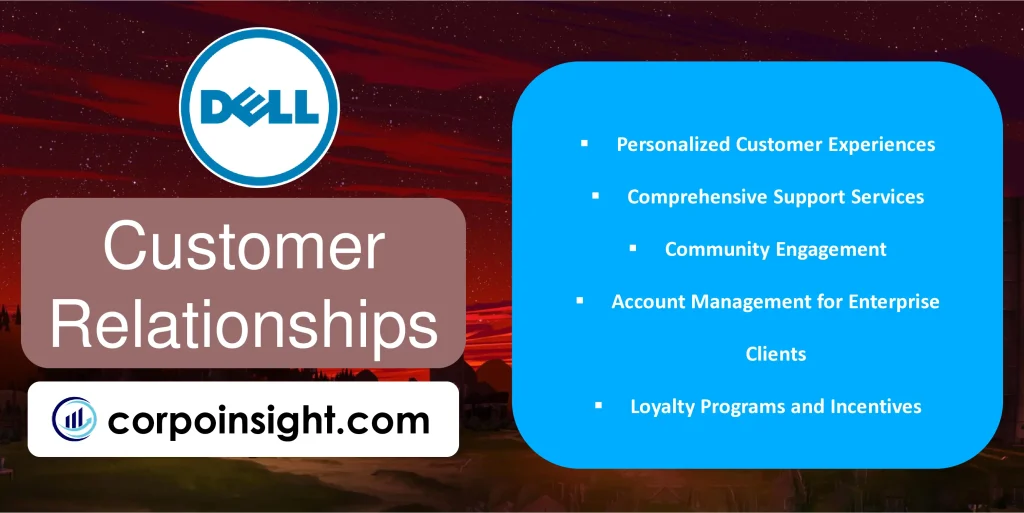
Personalized Customer Experiences: Dell leverages advanced analytics and AI to create tailored experiences for its customers; through its website and direct sales channels, the company offers personalized product recommendations and customized solutions, which not only enhance customer satisfaction but also drive sales and loyalty.
Comprehensive Support Services: Dell’s ProSupport and ProSupport Plus offerings provide customers with 24/7 technical assistance, proactive monitoring, and on-site support; these services, which have consistently received high satisfaction ratings, demonstrate Dell’s commitment to long-term customer relationships and have become a key differentiator in the competitive tech market.
Community Engagement: Through initiatives like Dell Technologies Forum and Dell User Groups, the company fosters a sense of community among its customers; these platforms facilitate knowledge sharing, provide insights into product roadmaps, and allow customers to influence future developments, thereby strengthening their connection to the Dell brand.
Account Management for Enterprise Clients: For large corporate and government customers, Dell assigns dedicated account managers who serve as single points of contact; this high-touch approach ensures that enterprise clients receive personalized attention, strategic guidance, and tailored solutions that align with their long-term IT objectives.
Loyalty Programs and Incentives: Dell’s rewards program, Dell Rewards, offers points on purchases that can be redeemed for discounts on future buys; additionally, the company provides special pricing and early access to new products for loyal customers, fostering long-term relationships and encouraging repeat business across its diverse product lines.
Key Activities – Dell Business Model Canvas
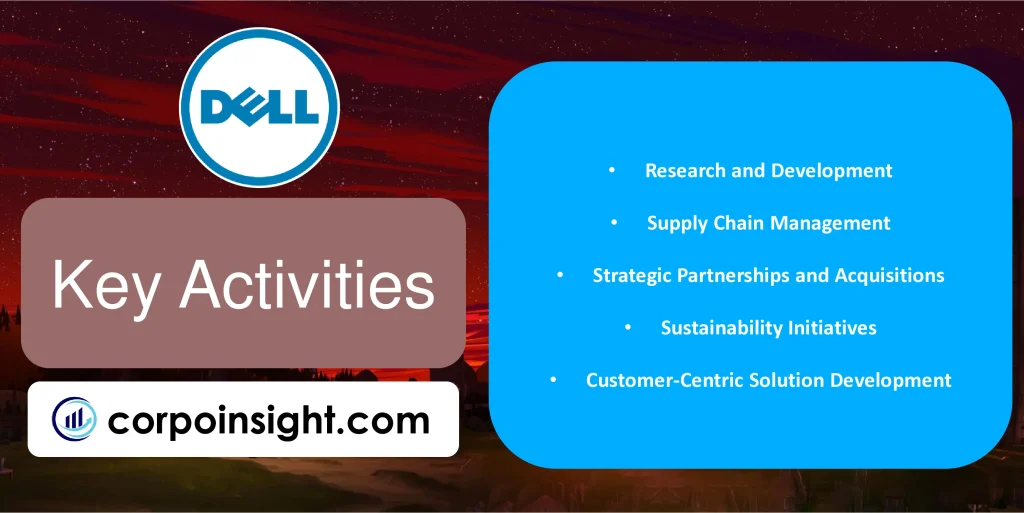
Research and Development: Dell invests heavily in R&D to maintain its competitive edge, with a focus on emerging technologies such as AI, edge computing, and 5G; in fiscal year 2024, the company spent approximately $5.3 billion on R&D, demonstrating its commitment to innovation across its product portfolio.
Supply Chain Management: Dell’s efficient supply chain remains a core competency, enabling rapid customization and delivery of products; the company continually optimizes its logistics network, as evidenced by its recent efforts to diversify manufacturing locations and implement AI-driven demand forecasting, which have improved resilience and reduced costs.
Strategic Partnerships and Acquisitions: Dell actively pursues partnerships and acquisitions to expand its capabilities and market reach; notable examples include the VMware spin-off in 2021, which generated significant value for shareholders, and ongoing collaborations with companies like NVIDIA to enhance Dell’s AI and high-performance computing offerings.
Sustainability Initiatives: Dell has intensified its focus on environmental sustainability, integrating it into key activities; the company’s 2030 goals include using 100% recycled or renewable materials in packaging and achieving net-zero greenhouse gas emissions, with initiatives like closed-loop recycling programs already showing significant progress.
Customer-Centric Solution Development: Dell’s approach to product and service development is heavily influenced by customer feedback and market trends; through programs like the Customer Solution Centers and Innovation Labs, Dell co-creates solutions with clients, ensuring that its offerings address real-world needs and challenges across various industries.
Key Resources – Dell Business Model Canvas

Intellectual Property and Patents: Dell’s innovative prowess is reflected in its extensive patent portfolio, which spans hardware, software, and services; as of 2023, the company held over 20,000 patents worldwide, providing a strong foundation for technological advancement and competitive differentiation in areas such as cloud computing and data management.
Global Manufacturing and Distribution Network: Dell’s efficient production and delivery capabilities rely on a vast network of manufacturing facilities and distribution centers; this global infrastructure, which includes strategic locations in the Americas, Asia, and Europe, enables Dell to optimize costs, reduce time-to-market, and maintain flexibility in response to changing market demands.
Human Capital: With a workforce of approximately 133,000 employees as of 2023, Dell’s talent pool represents a crucial resource; the company’s diverse and skilled workforce, spanning engineering, sales, and support functions, drives innovation and customer satisfaction, while Dell’s commitment to diversity and inclusion enhances its ability to attract and retain top talent.
Brand Equity and Customer Relationships: Dell’s strong brand recognition and customer loyalty, built over decades, constitute a valuable intangible asset; the company’s reputation for quality, reliability, and customer service, reinforced by initiatives like its Net Promoter Score program, contributes significantly to customer retention and acquisition across various market segments.
Financial Resources: Dell’s robust financial position, with a reported revenue of $102.3 billion in fiscal year 2024, provides the company with substantial resources for investment in growth initiatives, research and development, and strategic acquisitions; this financial strength enables Dell to navigate market fluctuations and pursue long-term strategic objectives effectively.
Key Partners – Dell Business Model Canvas

Technology Collaborators: Dell maintains strategic partnerships with leading technology companies to enhance its product offerings; notable examples include the long-standing collaboration with Intel for processor technology, and more recently, the expanded partnership with NVIDIA announced in 2023 to accelerate AI and high-performance computing solutions for enterprises.
Channel Partners and Resellers: The Dell Technologies Partner Program encompasses a vast network of resellers, distributors, and solution providers; this ecosystem, which includes over 200,000 partners globally as of 2023, plays a crucial role in extending Dell’s market reach and delivering tailored solutions to diverse customer segments.
Cloud Service Providers: Dell has forged strong partnerships with major cloud players to offer hybrid cloud solutions; the company’s multi-cloud strategy involves collaborations with Amazon Web Services (AWS), Microsoft Azure, and Google Cloud Platform, enabling Dell to provide comprehensive cloud integration services and expand its offerings beyond traditional hardware.
Independent Software Vendors (ISVs): Dell works closely with numerous ISVs to ensure software compatibility and optimize performance on Dell hardware; these partnerships, which span industries from healthcare to finance, enable Dell to offer complete, industry-specific solutions that integrate seamlessly with customers’ existing software ecosystems.
Sustainability Partners: In line with its commitment to environmental responsibility, Dell has established partnerships focused on sustainability; collaborations with organizations like NextWave Plastics for ocean-bound plastic recycling and Lonely Whale for promoting circular economy practices demonstrate Dell’s dedication to reducing its environmental impact through strategic alliances.
Cost Structure – Dell Business Model Canvas
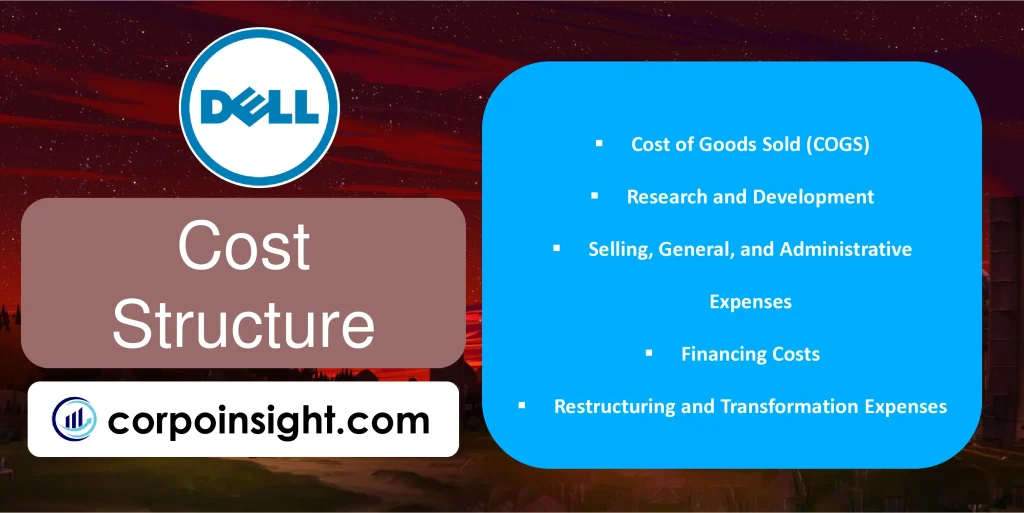
Cost of Goods Sold (COGS): As a hardware-centric company, Dell’s COGS represents a significant portion of its expenses, accounting for approximately 77% of net revenue in fiscal year 2024; this includes costs associated with manufacturing, materials, and logistics, which Dell continually strives to optimize through supply chain efficiencies and strategic sourcing agreements.
Research and Development: Dell’s commitment to innovation is reflected in its substantial R&D expenditure, which reached $5.3 billion in fiscal year 2024; this investment, while essential for maintaining competitiveness in the rapidly evolving tech industry, represents a significant fixed cost that Dell must balance against other operational expenses.
Selling, General, and Administrative Expenses: SG&A costs, which include marketing, sales force compensation, and administrative overhead, constituted about 16% of Dell’s net revenue in fiscal year 2024; while these expenses are necessary for maintaining Dell’s market presence and operational infrastructure, the company continually seeks ways to streamline these costs through digital transformation and operational efficiencies.
Financing Costs: As Dell leverages debt financing to fund operations and strategic initiatives, interest expenses represent a notable cost; in fiscal year 2024, the company reported interest and other expenses of $2.1 billion, highlighting the importance of managing its capital structure effectively to minimize financing costs.
Restructuring and Transformation Expenses: Dell periodically incurs costs related to organizational restructuring and business transformation initiatives; while these expenses can be significant in the short term, as evidenced by the $351 million in transformation expenses reported in fiscal year 2024, they are viewed as investments in long-term efficiency and competitiveness.
Summary of Dell Business Model Canvas

Conclusion on Dell Business Model Canvas
Dell’s Business Model Canvas reveals a company that has successfully evolved from a PC manufacturer to a comprehensive technology solutions provider. By leveraging its direct-to-consumer heritage, robust partner network, and innovative product portfolio, Dell maintains a strong market position. The company’s focus on customization, end-to-end solutions, and customer-centric support, coupled with strategic investments in emerging technologies and sustainability initiatives, positions Dell to navigate the dynamic tech landscape and meet diverse customer needs across multiple segments.

Majoring in marketing from Bangladesh University of Professionals, Sadman Abrar is a learner, obsessed with branding and intrigued to learn about different company strategies, and currently working at bKash.






